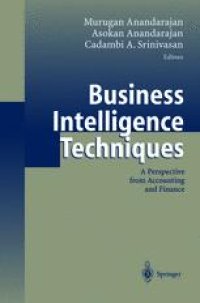
Ebook: Business Intelligence Techniques: A Perspective from Accounting and Finance
- Tags: Accounting/Auditing, Business Information Systems
- Year: 2004
- Publisher: Springer-Verlag Berlin Heidelberg
- Edition: 1
- Language: English
- pdf
Modern businesses generate huge volumes of accounting data on a daily basis. The recent advancements in information technology have given organizations the ability to capture and store these data in an efficient and effective manner. However, there is a widening gap between this data storage and usage of the data. Business intelligence techniques can help an organization obtain and process relevant accounting data quickly and cost efficiently. Such techniques include, query and reporting tools, online analytical processing (OLAP), statistical analysis, text mining, data mining, and visualization. Business Intelligence Techniques is a compilation of chapters written by experts in the various areas. While these chapters stand of their own, taken together they provide a comprehensive overview of how to exploit accounting data in the business environment.
Modern businesses generate huge volumes of accounting data on a daily basis. The recent advancements in information technology have given organizations the ability to capture and store these data in an efficient and effective manner. However, there is a widening gap between this data storage and usage of the data. Business intelligence techniques can help an organization obtain and process relevant accounting data quickly and cost efficiently. Such techniques include, query and reporting tools, online analytical processing (OLAP), statistical analysis, text mining, data mining, and visualization. Business Intelligence Techniques is a compilation of chapters written by experts in the various areas. While these chapters stand of their own, taken together they provide a comprehensive overview of how to exploit accounting data in the business environment.
Modern businesses generate huge volumes of accounting data on a daily basis. The recent advancements in information technology have given organizations the ability to capture and store these data in an efficient and effective manner. However, there is a widening gap between this data storage and usage of the data. Business intelligence techniques can help an organization obtain and process relevant accounting data quickly and cost efficiently. Such techniques include, query and reporting tools, online analytical processing (OLAP), statistical analysis, text mining, data mining, and visualization. Business Intelligence Techniques is a compilation of chapters written by experts in the various areas. While these chapters stand of their own, taken together they provide a comprehensive overview of how to exploit accounting data in the business environment.
Content:
Front Matter....Pages I-X
Historical Overview of Accounting Information Systems....Pages 1-19
Importance of Data in Decision-Making....Pages 21-39
Populating the Accounting Data Warehouse....Pages 41-54
The Accounting Centric Data WarehouseTM ....Pages 55-72
XBRL: A New Tool For Electronic Financial Reporting....Pages 73-92
Online Analytical Processing in Accounting....Pages 93-115
Bankruptcy Prediction Using Neural Networks....Pages 117-132
Visualization of Patterns in Accounting Data with Self-organizing Maps....Pages 133-147
Visual Representations of Accounting Information....Pages 149-166
Alignment of AIS with Business Intelligence Requirements....Pages 167-179
A Methodology for Developing Business Intelligence Systems....Pages 181-195
An OO Approach to Designing Business Intelligence Systems....Pages 197-212
Evaluating Business Intelligence: A Balanced Scorecard Approach....Pages 213-226
A Stakeholder Model of Business Intelligence....Pages 227-242
Back Matter....Pages 243-268
Modern businesses generate huge volumes of accounting data on a daily basis. The recent advancements in information technology have given organizations the ability to capture and store these data in an efficient and effective manner. However, there is a widening gap between this data storage and usage of the data. Business intelligence techniques can help an organization obtain and process relevant accounting data quickly and cost efficiently. Such techniques include, query and reporting tools, online analytical processing (OLAP), statistical analysis, text mining, data mining, and visualization. Business Intelligence Techniques is a compilation of chapters written by experts in the various areas. While these chapters stand of their own, taken together they provide a comprehensive overview of how to exploit accounting data in the business environment.
Content:
Front Matter....Pages I-X
Historical Overview of Accounting Information Systems....Pages 1-19
Importance of Data in Decision-Making....Pages 21-39
Populating the Accounting Data Warehouse....Pages 41-54
The Accounting Centric Data WarehouseTM ....Pages 55-72
XBRL: A New Tool For Electronic Financial Reporting....Pages 73-92
Online Analytical Processing in Accounting....Pages 93-115
Bankruptcy Prediction Using Neural Networks....Pages 117-132
Visualization of Patterns in Accounting Data with Self-organizing Maps....Pages 133-147
Visual Representations of Accounting Information....Pages 149-166
Alignment of AIS with Business Intelligence Requirements....Pages 167-179
A Methodology for Developing Business Intelligence Systems....Pages 181-195
An OO Approach to Designing Business Intelligence Systems....Pages 197-212
Evaluating Business Intelligence: A Balanced Scorecard Approach....Pages 213-226
A Stakeholder Model of Business Intelligence....Pages 227-242
Back Matter....Pages 243-268
....